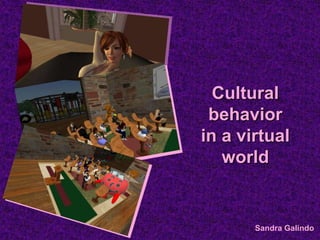
Cultural behavior in a virtual world
- 1. Cultural behavior in a virtual world Sandra Galindo
- 2. “An avatar is an interactive, social representation of a user” (Meadows, 2008, p.13)
- 3. The use of computers and the internet has help millions of people to enter virtual worlds were they interact with other people and create different identities. Ten years ago people interaction through the web was mostly concentrated in chat rooms, but with the technology advances the internet and computer users have developed in recent years, now it is possible for people to interact in virtual worlds.
- 4. This study was developed through three months. The methodology focused in observations during a IST graduate class in Second Life (SL) and the students interactions comparing them with how they interact in real life (RL). In order to develop the study I conduct four SL observations and two in the real life classroom. The SL observations were made during the class interaction in a virtual classroom and when they visit some educational sites in the virtual world.
- 5. “Second Life is a virtual world: a computer-generated place, created by real people from all across the world who log on to live other lives online”. (Guest, 2007, p.4) “In June 2003, when Second Life was launched, there were just five hundred residents, who spend an average of twenty hours a week in their virtual selves. By the end of my journey into virtual worlds, in May 2007, Second Life would be virtual home to 5.6 million. Other worlds would have millions more –for an estimated total around 70 million people worldwide”. (Guest, 2007, p.13)
- 6. “Itself a product of the American Dream, Second Life hordes of Kens and Barbies we call avatars. Like vehicles driven through an online landscape, they float blank-eyed in their magic kingdom, each hoping to strike it rich, become a star, find a friend or simply explore new possibilities” (Meadows, 2008, p.8) “In the real world, not everyone lives in a nice neighborhood with a loving family. In the virtual world; every neighborhood is pleasant, interesting, or fun. And while not everyone is loving, the dynamics of getting along with people certainly are different. No one can see your real skin color or body shape, so they can’t be mean to you along those lines, as they often are in the real world” (Castronova, 2007,p.69)
- 7. “By 2007, Second Life growth across the world had made U.S. player a minority: 31 percent, about 2.4 millions were American, and just over half (51percent) was European (of these France had the highest Second Life European population, followed by Germany, then the United Kingdom).” (Guest, 2007, p.27)
- 8. Educations have become a significant part inside Second Life. “Avatars are affecting education. According to a 2007 New York Times article, more than 100 Second Life islands have been sold for educational purposes; some of the buyers include Harvard, Stanford, Vassar, Pepperdine, Rice, University College Dublin, New York University, and the Australian Film Television and Radio School. Lawrence Lessing, Noam Chomsky, and other well known educators have made guest appearances in Second Life, in old-school, Socratic-style presentations” (Meadows, 2008, p.70)
- 9. Culture Education Virtual worlds Social interaction Communications Language
- 10. Study
- 11. During the research I observed people interactions in the virtual world, specifically 18 university instructional technology graduate students whose ages fluctuate between 25 and 57 years of age, some of them work as teachers and are taking classes in Second Life. There were observations of how these students act in real life when they are at the front of the computer connected with the virtual world and commanding their avatar.
- 14. Name of site: Orcus Lab 1 in Second Life. Proposed dates you will visit site this semester: Jan 27, 2009 Feb 3, 2009 Feb 10, 2009 Feb 17, 2009 Name of site: UTSA Classroom/Teaching lab MB Proposed dates you will visit site this semester: Feb 24, 2009 March 3, 2009 March 10, 2009
- 15. Lizzay Cephei Roux Students Jacob Angela Lonhorn
- 16. Tomothy Funizza Leonidas Razorback Cookie Koa Schweding Emperor Arden
- 17. Professor Magi Researcher Simone
- 18. Koa Rugani: that we scan so many words a minute. i didn't realize it was that big a number Cait Aycliffe: Good to teach using all possible sensory channels Leonidas Cyberstar: Me too Razorback Scribe: hearing processes the equivalent of 112k... eyes processes 3 TBs Roux Rexen: because we are learning the best way to use the visual thru tech for students to get the most. like scanning web pages like my teenager does Jackie Baudin: which makes sense wwhen compared to the speed of sound versus light dai Monday: the difference between hearing and eye process Longhorn Buccaneer: I think multimedia needs to attract more than one learning modality Cephei Mint: for the digital natives multitasking is like second nature Roux Rexen: that weas amazing about how little goes thru our ears Dayton Wirefly: I knew that optical input was larger than auditory input but I did not know by how much. That is quite surprising. Are our learning activities geared for that ratio of 1 to 200 for the visual channel? Leia Shackleton: lol made sense after all these years of teaching You: :)
- 19. Findings
- 20. Newbie avatar Resident avatar
- 21. Older people= more SL knowledge and use
- 23. Students interaction online Students interaction in RL Discussions Presentations Silence Boring More relaxed discussions/Difficult to catch up with discussions Monotony
- 25. References Castronova, Edward (2007). Exodus to the virtual word: How online fun is changing reality. New York, NY: Palgrave Macmillan. Guest, Tim (2007). Second Lives: A journey through virtual worlds. New York, NY: Random House. Meadows, M.S. (2008). I avatar:The culture and consequences of having a second life. Berkeley, CA: New Riders.